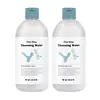What's inside
What's inside
 Key Ingredients
Key Ingredients

 Benefits
Benefits

 Concerns
Concerns

No concerns
 Ingredients Side-by-side
Ingredients Side-by-side

Water
Skin ConditioningPEG-6 Caprylic/Capric Glycerides
EmulsifyingDipropylene Glycol
HumectantButylene Glycol
HumectantCamellia Sinensis Leaf Water
MaskingPhenoxyethanol
PreservativeSodium Citrate
BufferingEthylhexylglycerin
Skin Conditioning1,2-Hexanediol
Skin ConditioningCamellia Sinensis Leaf Extract
AntimicrobialGlycyrrhiza Glabra Root Extract
BleachingAgrimonia Eupatoria Extract
AstringentDisodium EDTA
Citric Acid
BufferingPerilla Frutescens Leaf Extract
MaskingYucca Schidigera Root Extract
Skin ConditioningSapindus Mukorossi Fruit Extract
Skin ConditioningCucumis Sativus Fruit Extract
EmollientQuillaja Saponaria Bark Extract
CleansingSaponaria Officinalis Extract
Skin ConditioningBifida Ferment Lysate
Skin ConditioningLactobacillus Ferment Lysate
Skin ConditioningLactococcus Ferment Lysate
Skin ConditioningWater, PEG-6 Caprylic/Capric Glycerides, Dipropylene Glycol, Butylene Glycol, Camellia Sinensis Leaf Water, Phenoxyethanol, Sodium Citrate, Ethylhexylglycerin, 1,2-Hexanediol, Camellia Sinensis Leaf Extract, Glycyrrhiza Glabra Root Extract, Agrimonia Eupatoria Extract, Disodium EDTA, Citric Acid, Perilla Frutescens Leaf Extract, Yucca Schidigera Root Extract, Sapindus Mukorossi Fruit Extract, Cucumis Sativus Fruit Extract, Quillaja Saponaria Bark Extract, Saponaria Officinalis Extract, Bifida Ferment Lysate, Lactobacillus Ferment Lysate, Lactococcus Ferment Lysate
Water
Skin ConditioningPolyglyceryl-4 Caprate
EmulsifyingButylene Glycol
HumectantDipropylene Glycol
HumectantSea Water
HumectantBetaine
HumectantChlorphenesin
AntimicrobialEthylhexylglycerin
Skin Conditioning1,2-Hexanediol
Skin ConditioningCentella Asiatica Extract
CleansingParfum
MaskingDisodium EDTA
Sodium Hyaluronate
HumectantPentylene Glycol
Skin ConditioningLinalool
PerfumingCaprylyl Glycol
EmollientButylphenyl Methylpropional
PerfumingHexyl Cinnamal
PerfumingMacrocystis Pyrifera Extract
Skin ConditioningUndaria Pinnatifida Extract
Skin ConditioningSpirulina Platensis Extract
Skin ProtectingLaminaria Japonica Extract
Skin ProtectingGelidium Cartilagineum Extract
Skin ProtectingEnteromorpha Compressa Extract
Skin ProtectingSodium Citrate
BufferingCitric Acid
BufferingWater, Polyglyceryl-4 Caprate, Butylene Glycol, Dipropylene Glycol, Sea Water, Betaine, Chlorphenesin, Ethylhexylglycerin, 1,2-Hexanediol, Centella Asiatica Extract, Parfum, Disodium EDTA, Sodium Hyaluronate, Pentylene Glycol, Linalool, Caprylyl Glycol, Butylphenyl Methylpropional, Hexyl Cinnamal, Macrocystis Pyrifera Extract, Undaria Pinnatifida Extract, Spirulina Platensis Extract, Laminaria Japonica Extract, Gelidium Cartilagineum Extract, Enteromorpha Compressa Extract, Sodium Citrate, Citric Acid
Ingredients Explained
These ingredients are found in both products.
Ingredients higher up in an ingredient list are typically present in a larger amount.
1,2-Hexanediol is a synthetic liquid and another multi-functional powerhouse.
It is a:
- Humectant, drawing moisture into the skin
- Emollient, helping to soften skin
- Solvent, dispersing and stabilizing formulas
- Preservative booster, enhancing the antimicrobial activity of other preservatives
Butylene Glycol (or BG) is used within cosmetic products for a few different reasons:
Overall, Butylene Glycol is a safe and well-rounded ingredient that works well with other ingredients.
Though this ingredient works well with most skin types, some people with sensitive skin may experience a reaction such as allergic rashes, closed comedones, or itchiness.
Learn more about Butylene GlycolCitric Acid is an alpha hydroxy acid (AHA) naturally found in citrus fruits like oranges, lemons, and limes.
Like other AHAs, citric acid can exfoliate skin by breaking down the bonds that hold dead skin cells together. This helps reveal smoother and brighter skin underneath.
However, this exfoliating effect only happens at high concentrations (20%) which can be hard to find in cosmetic products.
Due to this, citric acid is usually included in small amounts as a pH adjuster. This helps keep products slightly more acidic and compatible with skin's natural pH.
In skincare formulas, citric acid can:
While it can provide some skin benefits, research shows lactic acid and glycolic acid are generally more effective and less irritating exfoliants.
Most citric acid used in skincare today is made by fermenting sugars (usually from molasses). This synthetic version is identical to the natural citrus form but easier to stabilize and use in formulations.
Read more about some other popular AHA's here:
Learn more about Citric AcidDipropylene Glycol is a synthetically created humectant, stabilizer, and solvent.
This ingredient helps:
Dipropylene glycol is technically an alcohol, but it belongs to the glycol family (often considered part of the ‘good’ alcohols). This means it is hydrating and gentle on skin unlike drying solvent alcohols like denatured alcohol.
As a masking agent, Dipropylene Glycol can be used to cover the smell of other ingredients. However, it does not have a scent.
Studies show Dipropylene Glycol is considered safe to use in skincare.
Learn more about Dipropylene GlycolDisodium EDTA plays a role in making products more stable by aiding other preservatives.
It is a chelating agent, meaning it neutralizes metal ions that may be found in a product.
Disodium EDTA is a salt of edetic acid and is found to be safe in cosmetic ingredients.
Learn more about Disodium EDTAEthylhexylglycerin (we can't pronounce this either) is commonly used as a preservative and skin softener. It is derived from glyceryl.
You might see Ethylhexylglycerin often paired with other preservatives such as phenoxyethanol. Ethylhexylglycerin has been found to increase the effectiveness of these other preservatives.
Sodium Citrate is the sodium salts of citric acid. In skincare, it is used to alter pH levels and acts as a preservative.
Its main functions are to maintain the pH of a product and neutralize metal ions.
The acidity of our skin is maintained by our glands and skin biome; normal pH level of skin is slightly acidic (~4.75-5.5).
Being slightly acidic allows our skin to create an "acid mantle". This acid mantle is a thin barrier that protects our skin from bacteria and contaminants.
Learn more about Sodium CitrateWater. It's the most common cosmetic ingredient of all. You'll usually see it at the top of ingredient lists, meaning that it makes up the largest part of the product.
So why is it so popular? Water most often acts as a solvent - this means that it helps dissolve other ingredients into the formulation.
You'll also recognize water as that liquid we all need to stay alive. If you see this, drink a glass of water. Stay hydrated!
Learn more about Water